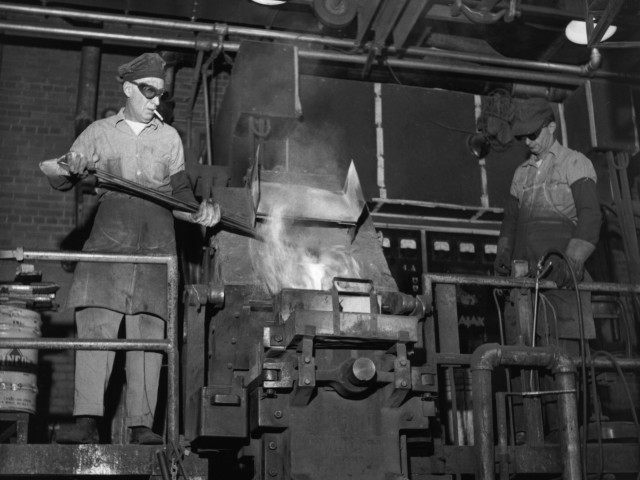Investment in new U.S. factory plant and equipment just hit the highest level since 1958. After 100 years of economic dominance due to cheap and abundant oil, U.S. politicians turned against domestic oil production in the 1970s and the Middle East oil production took off. For the next 40 years, the budget deficit and income inequality soared as high-paying manufacturing jobs went offshore. But with fracking re-establishing America as the planet’s largest energy producer, U.S. manufacturing is back.
Despite the 68 percent plunge in investment in petroleum and mining, the largest drop since 1986, spending on all types of production U.S. facilities increased 65 percent year-over-year in the second quarter, according to Bloomberg News. Even more impressive, for the last 12 months ending June, that pace averaged 64 percent.
The biggest driver of this manufacturing boom is that U.S. natural gas prices are again about a third as expensive as Europe and about a quarter of the cost in Asia. Given that the average cost of labor in manufacturing is 8.5 percent and energy is 13.5 percent, Asians could give away their labor and still not be competitive with the U.S.
The rebirth of America’s “comparable advantage” in energy costs is about the same as the percentage spread that existed from 1870 to 1970. America took away Britain’s reputation of “factory to the world,” and manufacturing’s dominance would later overwhelm Germany and Japan in world wars.
Plentiful manufacturing jobs and global dominance led to the creation of the first worker “middle class,” and what Stratfor refers to as systemic expectation of upward mobility. But with the rise of the environmental movement, U.S. energy production peaked in 1975 and relentlessly fell for the next 35 years. During the period, median U.S. household income actually fell by almost 10 percent as the middle class shrank.
At the depths of the Financial Crisis in 2010, over half of U.S. manufacturing jobs had moved offshore, US balance of payments imploded, national debt ballooned from 30 percent to 100 percent of GDP, and “Disposable Personal Income Per Capita” on an after-inflation basis fell by $3,437 as income inequality spiraled. Many economists predicted that the U.S. was in terminal financial decline and would soon suffer a currency crisis.
But since 2010, U.S. oil production has almost doubled, due to the rollout of fracking. American natural gas prices have collapsed from $5 to $2.75 per thousand cubic feet, and oil prices have plunged from over $100 to $47 per barrel. As a result, America’s balance of payment deficit has been cut in half and the U.S. “dollar is king” again.
“There’s a manufacturing boom underway tied to the chemical industry” building new plants that refine oil and natural gas into other products, Joe Carson, director of global economic research at AllianceBernstein LP in New York told Bloomberg. “The gift is long term. The energy renaissance triggers a manufacturing revival.”

COMMENTS
Please let us know if you're having issues with commenting.